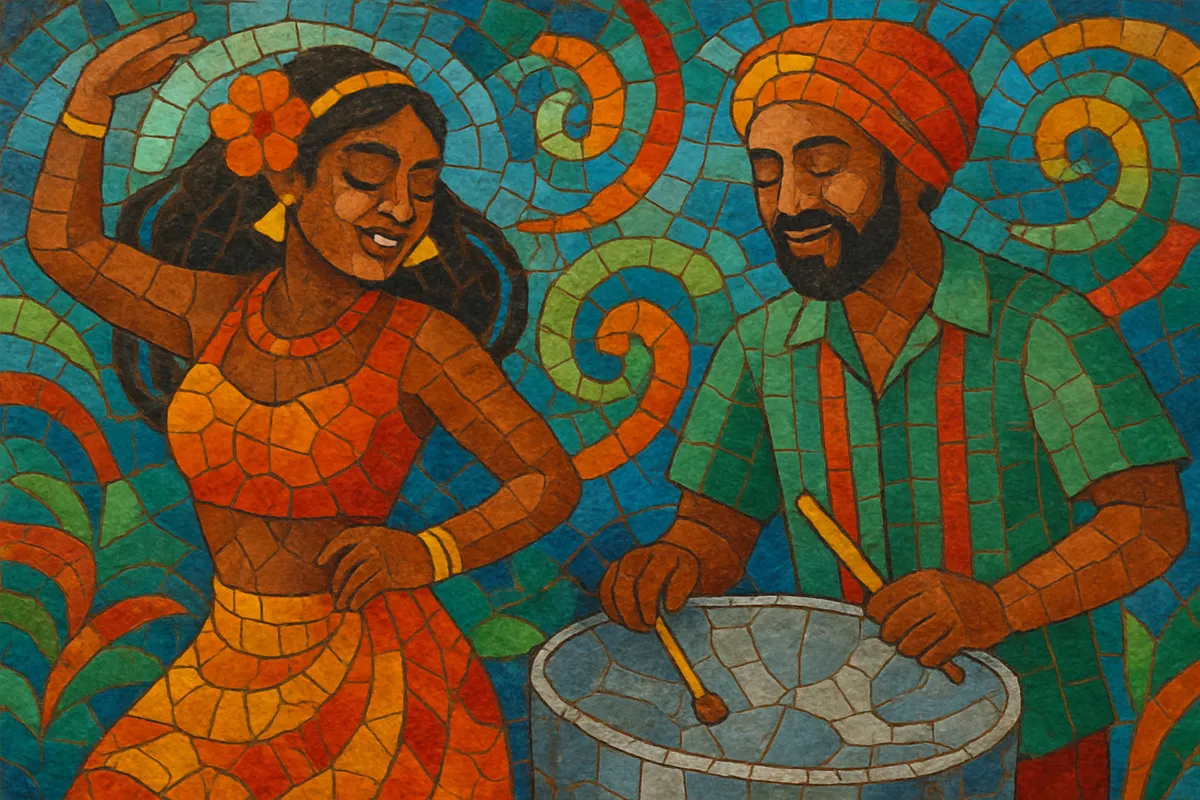
Chutney soca is a high-energy Indo-Caribbean fusion that blends the melodic and lyrical traditions of chutney (rooted in Bhojpuri folk and Hindu devotional song) with the driving rhythms, carnival spirit, and party aesthetics of Trinidadian soca.
It is typically bilingual or multilingual—mixing English/Trinidadian Creole with Hindi/Bhojpuri—and features harmonium, dholak, dhantal, and tassa drums alongside soca’s drum kit, synths, basslines, and brass. Tempos usually sit in the 120–150 BPM range, with earworm choruses, call-and-response hooks, and celebratory themes about love, family, rum, weddings, Holi (Phagwa), and fetes.
The sound is instantly danceable: soca’s four-on-the-floor thrust underpins tassa breaks and Indian melodic ornamentation, creating a festive, communal atmosphere that thrives in Carnival, wedding, and diaspora stages alike.
Chutney soca’s DNA comes from two parallel streams in Trinidad and Tobago: chutney (an Indo-Caribbean style drawing on Bhojpuri folk and Hindu devotional song) and calypso/soca (Afro-Caribbean popular music tied to Carnival). Pioneers such as Sundar Popo modernized chutney in the 1970s, while soca—emerging from calypso’s evolution—brought faster tempos and dance-floor focus. Experiments with Indian melodies and percussion in popular Trinidadian music during this period set the stage for a full fusion.
In the late 1980s, artists began explicitly branding the hybrid as “chutney soca.” Drupatee Ramgoonai’s breakthrough recordings (often cited as among the first to use the term) paired tassa-driven breaks and harmonium lines with soca rhythm sections and carnival-ready hooks. The hybrid’s identity solidified around bilingual lyrics, Indian melodic turns, and soca’s party-forward production.
By the 1990s, chutney soca was a staple of Carnival and wedding circuits across Trinidad and Tobago, Guyana, Suriname, and the wider diaspora (North America and the UK). Hitmakers like Rikki Jai and Sonny Mann popularized the sound on radio and stage. The launch of the annual Chutney Soca Monarch competition in Trinidad in the mid‑1990s helped codify performance formats—tassa breaks, crowd-call refrains, and big chorus payoffs—while raising production values and prize purses.
The 2000s saw new stars (Adesh Samaroo, Ravi B & Karma, KI & The Band, Raymond Ramnarine) and frequent crossovers with mainstream soca artists and bands. Arrangements incorporated contemporary pop and EDM touches while retaining hallmark Indo-Caribbean percussion and harmonium colors. The era brought both acclaim and debate over lyrical themes (especially rum and revelry), as well as broader visibility via streaming and diaspora festivals.
Chutney soca continues to thrive as a festive, community-centered music that bridges temples, wedding halls, and Carnival stages. It remains a living fusion—open to collaboration, bilingual storytelling, and modern production—while sustaining core aesthetics like tassa flourishes, call‑and‑response hooks, and celebratory narratives.
Aim for 120–150 BPM with a steady, danceable soca pulse. Use a four-on-the-floor kick, crisp snare/clap on 2 and 4, and bright hi-hats. Leave space for tassa interjections—short breaks or fills that lift transitions into choruses and outros.
Combine soca rhythm-section elements (drum kit, electric bass, synths/keys, optional brass) with Indo-Caribbean instruments (harmonium for chords/melody, dholak for rolling midrange rhythms, dhantal for metallic timekeeping, and a tassa ensemble for climactic breaks). Optional colors include sitar and tabla. Layer handclaps and crowd shouts to enhance the fête energy.
Use simple, major-key progressions (I–V–vi–IV, I–IV–V) to foreground catchy vocal hooks. Write melodies that allow Indian ornamentation—slides, mordents, and turns evocative of raga phrasing—without sacrificing sing-along clarity. Keep choruses concise and repetitive to encourage call-and-response.
Blend English/Trinidadian Creole with Hindi/Bhojpuri. Themes include celebration, romance, wedding culture, Holi/Phagwa, playful teasing (dougla/jokey banter), and rum/fête life. Write direct, uplifting lines and include shout‑outs or commands that invite audience participation.
Typical form: Intro (tassa roll + synth/harmonium hook), Verse, Pre‑Chorus, Big Chorus, Short Tassa Break, Verse 2, Chorus, Bridge or Rap/Call section, Extended Tassa/Instrumental Break, Final Chorus (often lifted with added harmonies or key change). Keep transitions punchy and dancefloor‑focused.
Tighten the low end with a focused kick–bass relationship; sidechain subtly if using modern pop/EDM elements. Brighten harmonium and dhantal with tasteful high‑shelf EQ and plate/hall reverb. Pan percussion for width (tassa rolls slightly wide, dhantal centered). Preserve dynamic impact by reserving the fullest arrangement for the chorus and final run‑out.

